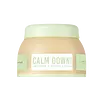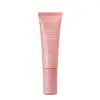What's inside
What's inside
 Key Ingredients
Key Ingredients

 Benefits
Benefits

 Concerns
Concerns

No concerns
 Ingredients Side-by-side
Ingredients Side-by-side

Water
Skin ConditioningGlycerin
HumectantDicaprylyl Ether
EmollientButylene Glycol
HumectantHydrogenated Ethylhexyl Olivate
EmollientPentylene Glycol
Skin Conditioning1,2-Hexanediol
Skin ConditioningPanthenol
Skin ConditioningHydrogenated Polydecene
EmollientSaccharide Isomerate
HumectantHydroxyethyl Acrylate/Sodium Acryloyldimethyl Taurate Copolymer
Emulsion StabilisingAcrylates/C10-30 Alkyl Acrylate Crosspolymer
Emulsion StabilisingPolymethylsilsesquioxane
Hydrogenated Olive Oil Unsaponifiables
EmollientBoron Nitride
AbsorbentMadecassoside
AntioxidantAloe Barbadensis Leaf Extract
EmollientAllantoin
Skin ConditioningArtemisia Vulgaris Extract
Skin ConditioningAstrocaryum Murumuru Seed Butter
EmollientGlyceryl Acrylate/Acrylic Acid Copolymer
HumectantTromethamine
BufferingEthylhexylglycerin
Skin ConditioningXanthan Gum
EmulsifyingDipotassium Glycyrrhizate
HumectantSodium Phytate
Ceramide NP
Skin ConditioningSodium Citrate
BufferingCitric Acid
BufferingSea Water
HumectantPropanediol
SolventTocopherol
AntioxidantEmiliania Huxleyi Extract
Skin ConditioningWater, Glycerin, Dicaprylyl Ether, Butylene Glycol, Hydrogenated Ethylhexyl Olivate, Pentylene Glycol, 1,2-Hexanediol, Panthenol, Hydrogenated Polydecene, Saccharide Isomerate, Hydroxyethyl Acrylate/Sodium Acryloyldimethyl Taurate Copolymer, Acrylates/C10-30 Alkyl Acrylate Crosspolymer, Polymethylsilsesquioxane, Hydrogenated Olive Oil Unsaponifiables, Boron Nitride, Madecassoside, Aloe Barbadensis Leaf Extract, Allantoin, Artemisia Vulgaris Extract, Astrocaryum Murumuru Seed Butter, Glyceryl Acrylate/Acrylic Acid Copolymer, Tromethamine, Ethylhexylglycerin, Xanthan Gum, Dipotassium Glycyrrhizate, Sodium Phytate, Ceramide NP, Sodium Citrate, Citric Acid, Sea Water, Propanediol, Tocopherol, Emiliania Huxleyi Extract
Water
Skin ConditioningCaprylic/Capric Triglyceride
MaskingSaccharide Isomerate
HumectantSchizophyllan
HumectantPentylene Glycol
Skin ConditioningButylene Glycol
HumectantPropanediol
SolventIsononyl Isononanoate
EmollientNiacinamide
SmoothingXylitylglucoside
HumectantAnhydroxylitol
HumectantXylitol
HumectantLaureth-30
CleansingHydroxyethylcellulose
Emulsion StabilisingAcetyl Dipeptide-1 Cetyl Ester
Skin ConditioningMagnesium Aspartate
Skin ConditioningZinc Gluconate
Skin ConditioningCopper Gluconate
Skin ConditioningPhenoxyethanol
PreservativePortulaca Oleracea Extract
Skin ConditioningCeramide NP
Skin ConditioningPEG-7 Glyceryl Cocoate
EmulsifyingAsiaticoside
AntioxidantAsiatic Acid
Skin ConditioningMadecassic Acid
Skin ConditioningEthylhexylglycerin
Skin ConditioningPolyacrylate-13
Polyisobutene
Polysorbate 20
EmulsifyingSorbitan Isostearate
EmulsifyingAloe Barbadensis Leaf Juice
Skin ConditioningPotassium Sorbate
PreservativeSodium Benzoate
MaskingHydrolyzed Royal Jelly Protein
Skin ConditioningGlycerin
HumectantCalendula Officinalis Flower Extract
MaskingSodium Acrylates Copolymer
Lecithin
EmollientHyaluronic Acid
HumectantAllantoin
Skin ConditioningDisodium EDTA
Carbomer
Emulsion StabilisingTocopheryl Acetate
AntioxidantDipotassium Glycyrrhizate
HumectantMaltodextrin
AbsorbentWater, Caprylic/Capric Triglyceride, Saccharide Isomerate, Schizophyllan, Pentylene Glycol, Butylene Glycol, Propanediol, Isononyl Isononanoate, Niacinamide, Xylitylglucoside, Anhydroxylitol, Xylitol, Laureth-30, Hydroxyethylcellulose, Acetyl Dipeptide-1 Cetyl Ester, Magnesium Aspartate, Zinc Gluconate, Copper Gluconate, Phenoxyethanol, Portulaca Oleracea Extract, Ceramide NP, PEG-7 Glyceryl Cocoate, Asiaticoside, Asiatic Acid, Madecassic Acid, Ethylhexylglycerin, Polyacrylate-13, Polyisobutene, Polysorbate 20, Sorbitan Isostearate, Aloe Barbadensis Leaf Juice, Potassium Sorbate, Sodium Benzoate, Hydrolyzed Royal Jelly Protein, Glycerin, Calendula Officinalis Flower Extract, Sodium Acrylates Copolymer, Lecithin, Hyaluronic Acid, Allantoin, Disodium EDTA, Carbomer, Tocopheryl Acetate, Dipotassium Glycyrrhizate, Maltodextrin
 Reviews
Reviews

Ingredients Explained
These ingredients are found in both products.
Ingredients higher up in an ingredient list are typically present in a larger amount.
Allantoin is a soothing ingredient known for its protective and moisturizingg properties. Because of this, it is often added to products with strong active ingredients.
Studies show higher concentrations of this ingredient can promote wound healing.
Though it can be derived from the comfrey plant, allantoin is produced synthetically for cosmetic products to ensure purity.
Learn more about AllantoinButylene Glycol (or BG) is used within cosmetic products for a few different reasons:
Overall, Butylene Glycol is a safe and well-rounded ingredient that works well with other ingredients.
Though this ingredient works well with most skin types, some people with sensitive skin may experience a reaction such as allergic rashes, closed comedones, or itchiness.
Learn more about Butylene GlycolCeramide NP is a type of ceramide and formally known as ceramide 3.
Ceramides are intercellular lipids naturally found in our skin that bonds dead skin cells together to create a barrier. They are known for their ability to hold water and thus are a great ingredient for dry skin.
Ceramides are an important building block for our skin barrier. A stronger barrier helps the skin look more firm and hydrated. By bolstering the skin ceramides act as a barrier against irritating ingredients. This can help with inflammation as well.
If you would like to eat ceramides, sweet potatoes contain a small amount.
Read more about other common types of ceramides here:
Ceramide AP
Ceramide EOP
Dipotassium Glycyrrhizate comes from licorice root.
Extracts of licorice have demonstrated to have antibacterial, anti‐inflammatory, antiviral, antioxidant properties.
One component, glabridin, has extra potent antioxidant and soothing properties. It has also been found to block pigmentation from UVB rays in guinea pigs.
Licorice Root also contains a flavonoid. Flavonoids are a natural substance from in plants. Flavonoids also have antioxidant properties.
Another component, glycyrrhizin, has been found to have anti-inflammatory and antimicrobial benefits. This may make licorice root extract effective at treating acne. However, more research is needed to support this.
Liquiritin is one of the flavone compounds found in licorice. It has been found to help lighten skin by preventing tyrosinase from reacting with tyrosine. When the two react, protein is converted to melanin. Melanin is the substance in your body that gives your features pigmentation.
Licorice root is native to Southern Europe and Asia. It has been used in traditional Chinese medicine to help with respiratory issues.
Learn more about Dipotassium GlycyrrhizateEthylhexylglycerin (we can't pronounce this either) is commonly used as a preservative and skin softener. It is derived from glyceryl.
You might see Ethylhexylglycerin often paired with other preservatives such as phenoxyethanol. Ethylhexylglycerin has been found to increase the effectiveness of these other preservatives.
Glycerin is already naturally found in your skin. It helps moisturize and protect your skin.
A study from 2016 found glycerin to be more effective as a humectant than AHAs and hyaluronic acid.
As a humectant, it helps the skin stay hydrated by pulling moisture to your skin. The low molecular weight of glycerin allows it to pull moisture into the deeper layers of your skin.
Hydrated skin improves your skin barrier; Your skin barrier helps protect against irritants and bacteria.
Glycerin has also been found to have antimicrobial and antiviral properties. Due to these properties, glycerin is often used in wound and burn treatments.
In cosmetics, glycerin is usually derived from plants such as soybean or palm. However, it can also be sourced from animals, such as tallow or animal fat.
This ingredient is organic, colorless, odorless, and non-toxic.
Glycerin is the name for this ingredient in American English. British English uses Glycerol/Glycerine.
Learn more about GlycerinPentylene glycol is typically used within a product to thicken it. It also adds a smooth, soft, and moisturizing feel to the product. It is naturally found in plants such as sugar beets.
The hydrophilic trait of Pentylene Glycol makes it a humectant. As a humectant, Pentylene Glycol helps draw moisture from the air to your skin. This can help keep your skin hydrated.
This property also makes Pentylene Glycol a great texture enhancer. It can also help thicken or stabilize a product.
Pentylene Glycol also acts as a mild preservative and helps to keep a product microbe-free.
Some people may experience mild eye and skin irritation from Pentylene Glycol. We always recommend speaking with a professional about using this ingredient in your routine.
Pentylene Glycol has a low molecular weight and is part of the 1,2-glycol family.
Learn more about Pentylene GlycolPropanediol is an all-star ingredient. It softens, hydrates, and smooths the skin.
It’s often used to:
Propanediol is not likely to cause sensitivity and considered safe to use. It is derived from corn or petroleum with a clear color and no scent.
Learn more about PropanediolSaccharide Isomerate comes from sugars found in corn. It is a skin hydrator.
The structure of this ingredient can be altered to be more similar to the carbohydrates found in our skin. This ability to mimic our skin gives it hydrating properties.
Specifically, saccharide Isomerate is a humectant. Humectants draw moisture from the air to our skin.
Research shows Saccharide Isomerate to be an effective moisturizer.
Learn more about Saccharide IsomerateWater. It's the most common cosmetic ingredient of all. You'll usually see it at the top of ingredient lists, meaning that it makes up the largest part of the product.
So why is it so popular? Water most often acts as a solvent - this means that it helps dissolve other ingredients into the formulation.
You'll also recognize water as that liquid we all need to stay alive. If you see this, drink a glass of water. Stay hydrated!
Learn more about Water